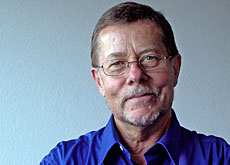Giant traffic arteries

In the context of the North-American Free Trade Agreement (NAFTA), Americans have recently encountered the curious myth of the "NAFTA Superhighway."
This story of an imagined new mass transportation artery from Mexico to Canada may remind Swiss readers of the long-running issue of goods transfer across the Alps, or the National Rail Links Through the Alps (NRLA) project.
Two years ago, mid-level officials from the US, Mexico, and Canada started discussing easier coordination of customs and security procedures for trade among the three countries. Meanwhile, the Mexican Pacific coast deep-water port of Lázaro Cárdenas has been undergoing massive upgrades. And in Kansas City, already a transportation hub, forward-looking businesses are pushing for the place to become a giant “smart port,” a kind of inter-modal transportation and cargo center.
Joining the dots, critics see the emergence of the NAFTA Superhighway – a 400-meter-wide artery with Mexican-driven trucks, trains, pipelines, and communication cables, which will wipe out farms, small cities and countryside, regardless of local needs. Even ordinary Texans, used to things on a big scale, fear a new behemoth of trans-continental commodity movements.
Avalanche in the Alps
In a rough parallel, for Switzerland, the alpine transit issue has become a key element of transportation policy. Can the tide of goods from north to south and back be channeled from the roads to railroad lines and tunnels, as foreseen by the NRLA, the new rail link through the Alps? The government has its planning firmly in place, the Gotthard base tunnel is well advanced, and the pressures for success are ever present because of urgings from the European Union. But will ordinary Swiss accept the fast-developing avalanche of goods across their mountains?
The port of Lázaro Cárdenas – which is not unionized – when finished, could absorb most of the Asian trade now coming in through Los Angeles and Long Beach, that is, 80 per cent of all US imports from Asia. Kansas City would grow into a mega-scale traffic handling and distribution center. Thanks to the mountains, in the Swiss case some of the commodities’ stream would flow underground so that the cantons of Uri, Graubünden, Ticino, and Valais can anticipate a rapid revitalization of their tourism industry: idyllic playgrounds above the trans-European conveyor belts.
Private versus public money
While the magnitude of future trade and transportation demands raises similar questions in both countries, the expectations depend on who is in charge: in the US, it is largely private market forces that seem to dominate the planning. For example, toward the northern end of the “Superhighway” in Detroit, the Ambassador Bridge – which carries one-third of all US-Canadian road trade – is privately owned and may remain in private hands even if a needed new bridge is built. In Switzerland, the government has taken the lead in projecting and preparing construction, installation, and financing of the alpine transit link as a matter of course.
Questions and anxieties about the future of transportation are no different from uncertainties about sufficient clean air, water, and living space in the future. Such questions arise all at the same time. Answers would seem to have to come from new technologies imaginatively applied. Public, private, and non-profit actors and institutions in both countries face the task of taking future arteries into account and trying to harness technical means and financial allocation so as to meet steadily evolving demands as they arise. I suspect the Swiss have been able to do this better so far than the Americans because they feel the pressure more acutely. In the US, space, if not time, is more forgiving.
But there is a caveat even there: business may look ahead and plan on its own terms. A popular suspicion of conspiracy theorists is that big capital, in cahoots with government, is giving away the country. But the private sector will not be able to provide another 280,000 miles of highways for 78 million more cars and trucks that are expected to jam roads by 2040. Thus government – that is, the people’s authority – should be in charge: smart, competent, and forward-looking.
by Jurg Siegenthaler
The views expressed in this column are not necessarily those of swissinfo.
Every month retired professor, Jurg Siegenthaler, compares and contrasts aspects of life in Switzerland with that of his adopted homeland, the United States.
He emigrated to the United States from Switzerland in 1967, and is now a retired university professor living close to Washington, DC. He is a graduate of Bern University (Dr.rer.pol., 1966).
His fields of teaching and research encompassed economic history, social theory and social policy analysis. Throughout his career, he has maintained close comparative research interests in the US and Switzerland.
He is associated with the Institute for Socio-Financial Studies, a research non-profit that has done a lot of work improving financial literacy at the community level.
Since his retirement, Jurg Siegenthaler has broadened his involvement in community organizations and in the arts. He is married and lives with his wife Linda in Silver Spring, Maryland.

In compliance with the JTI standards
More: SWI swissinfo.ch certified by the Journalism Trust Initiative









You can find an overview of ongoing debates with our journalists here . Please join us!
If you want to start a conversation about a topic raised in this article or want to report factual errors, email us at english@swissinfo.ch.